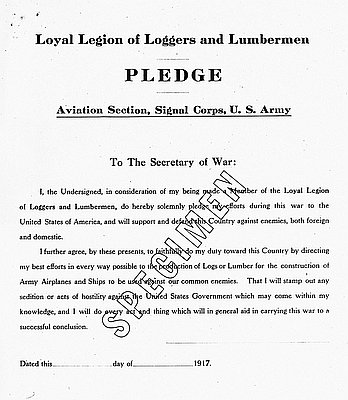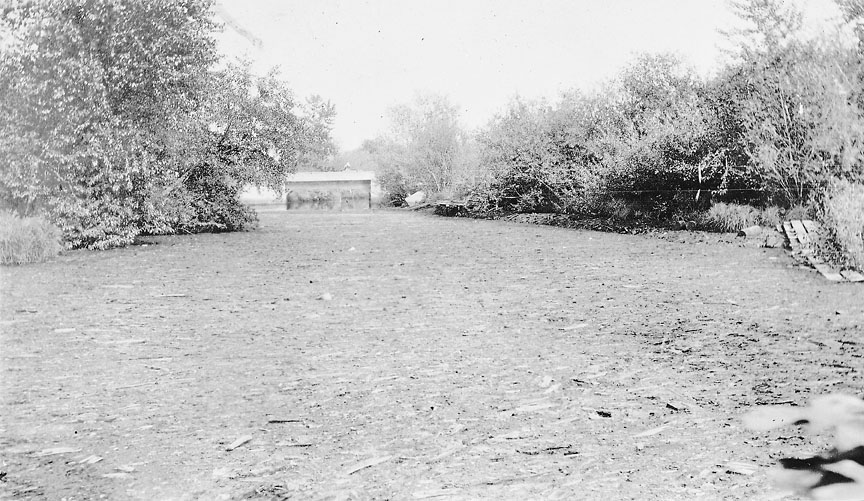- Catalog No. —
- OrHi 93594
- Date —
- 1929
- Era —
- 1921-1949 (Great Depression and World War II)
- Themes —
- Environment and Natural Resources, Trade, Business, Industry, and the Economy
- Credits —
- Oregon Historical Society
- Regions —
- Willamette Basin
- Author —
- Ralph Penniwell Cowgill
Booth-Kelly Mill Waste, 1929
This photograph of lumber waste at the Booth Kelly Lumber Mill, in Springfield, Oregon, was taken in 1929 by Ralph Penniwell Cowgill, an engineer for Oregon’s State Game Commission. He included the photo in a pictoral report of “Miscellaneous Sawmill Pollution” in Oregon.
Although both Oregon and Washington passed laws against the dumping of sawdust into salmon-bearing streams as early as the 1870s, the laws were seldom enforced. Pointing to scenes like the waterway in this photograph by Cowgill, advocates for cleaner waterways argued that the wood waste disposed by sawmills into adjacent rivers and streams destroyed local fish populations and the habitats that they depended upon for their survival. Sawdust dumped into streams became trapped in fish gills, slowly suffocating them, but eventually settled onto the stream floor, covering fish spawning habitat and killing off substantial portions of the food chain. Floating waste blocked sunlight, interrupting the photosynthesis needed by underwater plants to survive and continue to convert carbon dioxide into oxygen, a condition made worse by the oxygen absorbing wood rotting away at all depths of the stream.
With roughly a third of each tree milled contributing to the waste build-up, sawdust and other solid wood wastes piled up quickly in the mills, creating an ever-present fire hazard. Cheaper insurance rates for mills that employed sawdust removal strategies encouraged mill owners to get rid of the waste as best as they could. Consequently, they either dumped the waste on nearby land, burned it in open pits, or had it thrown into the nearest waterway. At some mills, a portion of the waste was also used to power generators used within the mill.
Beginning in the 1880s, mills began to utilize patented wood burners that were fed waste non-stop, sometimes burning consistently for decades without being extinguished. Over time, some owners began to slowly reduce the volume of burnable waste by maximizing the use of the smaller pieces of wood, turning them into tool handles, shingles, and lathe. And, as steam-powered electrical plants became more advanced, a large market developed for “hogged fuel,” which was made by putting edgings, shavings, bark, unused slabs of wood, and sawdust through an industrial-strength chipper known as a fuel hog. The dense mix of wood chippings mixed with sawdust burned well in the boilers of electric generating plants.
Further Reading:
Bunting, Robert. The Pacific Raincoast: Environment and Culture in an American Eden, 1778–1900. Lawrence, Kan.: 1997.
Hodgson, Allen H. “Present Utilization of Sawmill “Waste” in the Douglas Fir Region.” Parts 1 – 4. The Timberman 32, 1931: 9:27–33, 10:25–31, 11:32–40, 12:36–46.
Lichatowich, Jim. Salmon Without Rivers: A History of the Pacific Salmon Crisis. Washington, D.C.: 1999.
Written by Joshua Binus, © Oregon Historical Society, 2004.
Related Historical Records
-
Loyal Legion of Loggers & Lumbermen Pledge
This “specimen” of the “Four-L Pledge” was originally devised under the leadership of the U.S. War Department’s Col. Brice P. Disque as part of a larger strategy to …

-
Sugar Pine Door & Lumber Company
The Scottish botanist David Douglas described the sugar pine (Pinus lambertiana) as the “most princely of the genus.” Sugar pines are the tallest pines in the world, often growing to …

-
The Coastal Lumber Industry
It was clear by the last decades of the nineteenth century how logging was altering the coastal landscape. In 1872, writer Frances Fuller Victor visited the renascent town …
